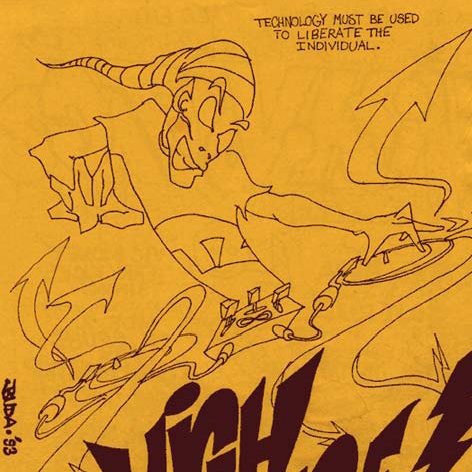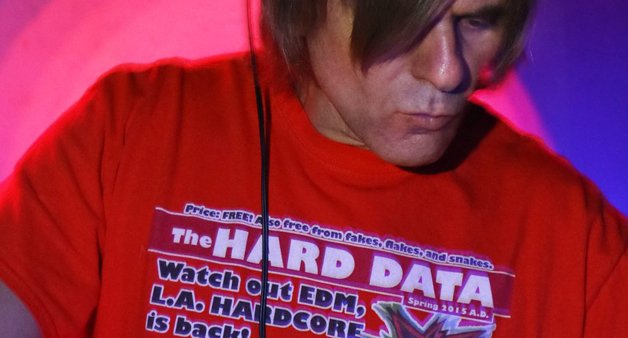“King of Style” is a techno track that took three decades to make. As many of you know, the track is made from audio and video samples from what is regarded as the first Hip Hop Documentary, Style Wars, a movie that mesmerized me from the day I saw it and echoes in my head to this day. From 1983 onward, the movie had catalyzed millions of Hip Hop lovers around the globe. When I started producing rave music in 1994, one of the first things I wanted to do was sample Style Wars and make it into a rave track. But, because I loved the movie so much, I agonized over every detail. In my mind, every attempt I made was never good enough. Slowly but surely though, life (or more accurately) the realization that life could quickly end, would bring the project into being.
The first time I saw Style Wars was 1985, when it appeared on PBS, WQED Channel 13 in Pittsburgh, PA. I already had heard about the film, and “recorded” it as best I could, with an audio cassette deck. At the time, VHS and Betamax television recorders were still expensive and my family didn’t have one. From that day on, me and my graffiti friends would listen to the audio cassette over and over as we practiced our lettering and character styles. We could practically recite the entire movie if asked. I was always obsessed with lettering styles, and so Kase 2, the graffiti artist that invented “computer rock” style was my favorite graffiti writer in the movie. I loved everything he said in the movie, and me and my friends would pepper our everyday language with his seemingly random extra-galactic vernacular. We called each other, “The fresh extra-tellestrial (sic) brothers”, and called things “super-duty-tuff-work” on a regular basis.
But in retrospect, the thing that resonated most with me about Kase 2 was his dedication to inventing new lettering styles. That simple love of innovation in the visual arts, or anywhere in life, that joy in creation, is what inspired me. Sure, like many male dominated fields, graffiti was competitive, and I liked that, but at its heart it was constructive. It was making something, and wanting to make something good, for goodness’s sake. That was the goal. This felt natural to me.
In the mid-80’s there was an airline called “People’s Express”. For $49 Round-trip you could fly from Pittsburgh to New York and Boston, and me and my graffiti crew, Badassest, often did so to paint in each other’s city. During this time I would frequent Henry Chalfant’s studio in Soho, where famous graffiti artists would congregate. Making acquaintance and befriending some, I would develop my own lettering style, later known as “monster rock”. I would constantly bug the heck out of everyone asking them, “What do you think of this style?” after every twitch of my pencil.
One day, as Chalfant was on his way to photograph a wall for his upcoming book “Spray Can Art” book, I tagged along with who would become an internationally famous graffiti writer, T-Kid 170. During that trip, T-Kid gave me the “Wildstyle Card”. This was a membership to one of New York’s biggest and most legendary graffiti crews, started by Tracy 168. But, that was not all. At one point in the journey we had to make a stop to see Kase 2. I was thrilled as you could imagine and once he got in the car I immediately started drawing my version of computer rock. But, since I was so rushed and nervous meeting one of my all-time heroes, it came out kind-of-wack. Kase was like, “um…”, and frankly seemed to have his mind on other things than graffiti, anyway. But, nonetheless, I got to tell him how great I thought he was. So, though not a perfect experience, I look back at it with a lot of fondness.
In the course of hanging out with all these graffiti writers, I invariably would hear background stories of beefs, collaborations, history, and behind-the-scenes goings on during the filming of Style Wars. Some of these stories would eventually influence the way I edited the “King of Style” video, decades later.
For example, though Cap comes off in the movie as some sort of racist thug, he actually did pieces and whole car paintings. One of which was filmed during the making of the movie, seen at 2:54 in the King of Style video. Basically, showing anything but Cap’s throw-ups didn’t fit the narrative of the original story, and this footage can only be seen in the outtakes. So, I wanted to give a bit of the “other side” of the story after all these years. Also, something most people won’t realize today, is that back then in New York, everyone in the graffiti scene used the word “nigger” to describe friend and foe alike, be they black, white or otherwise. I believe I heard that Cap even used to piece with Kase occasionally! So, to some degree Cap’s dialogue wasn’t as racist as modern viewers, and viewers outside of New York in the 1980’s, might think.
At 3:37 in King of Style… see that kid all the way to the left, in the white sweater and gloves making the hand move? Well, the story with him is that Mom was so worried he would be dressed right for the filming, she kept him in too long prepping him. He never made it on time and missed the prime shooting window! So, I wanted to make sure his Mom’s hard work was finally appreciated!
When selecting the train footage, I tried my best to get examples of wildstyle lettering on the trains. Usually the public sees more of the glossy work by Seen, Lee and Dondi from this period, but what I remember going on at that time was skinny, angular wild styles by crews like FBA (Fast Breakin’ Artists) and I tried to salvage as many examples as I could from the outtakes. And, just an aside, I think one of the things I like most about the Style Wars outtake footage, is that it reminds me of those hot, humid summers in 1980’s New York. There was freedom in the air then with its own distinct character. I wonder if younger viewers can see that in the film, as I do. I wonder if it registers as being any different than their current experience.
Many songs and tracks have sampled Style Wars, but usually the samples floated in the background of the music. I wanted my samples to be upfront and bold, as if they were lyrics to a song, and in the back of my mind, I always wanted the original video to be featured in some way. So, around 2011, when I was able to help with the film’s restoration project, in passing I mentioned to Public Art Films that I could make an electronic remix of the footage, and no one said, “no.” So, that encouraged me to keep poking away at ideas on how I would feature the material in an electronic dance music track.
Ultimately the catalyst that made me finally commit to finishing the track was a tragedy that happened in my life. A fire destroyed virtually everything I owned, my records, art, letters… all gone. Being present during the fire, I realized that in a split second, everything can change, and if I ever wanted to finally make the track that had been banging in the back of my mind, now was the time. Fortunately, following the chaos of the New York stop on the Trauma Live Tour, I ran into my old rave friend, Lenny Dee, who was interested in the possibilities of the track (and eventually tweaked it for mass consumption, the original mix appears in world’s first blockchained DJ mix, “Rock the Blockchain“) and encouraged me to go forward. He even gave me advance samples from his upcoming audio sample packs (Industrial Strength Samples) that I made sure to use in the track. Much as Kase 2, Tracy 168, Lee, T-Kid, A-1, Daze or Phase 2 were inspirations to me in graffiti, Lenny has always been someone I listen to before creating my music. He’s a master that can’t help but share his experience and can easily be judged by the myriad of artists and tracks he has launched and showcased over the decades.
I would spend much of the summer of 2016 working on the track. The one aspect that I wanted to incorporate, that I felt needed in the track, was horns. Horns or saxophone like in the Jimmy Castor Bunch’s “It’s Just Begun.” I’ll never forget the time I heard Marley Marl scratching up two copies of “It’s Just Begun” on his Saturday night WBLS mix show in New York. The “transformer scratch” technique had just come out, and Marley Marl made sure to “transform” just about every jam he played that night. I was lucky enough to record him slicing up two copies of “It’s Just Begun” and I listened to it all summer. Of course, “It’s Just Begun” was already dated by the time I heard it as a teenager, but until this day, no song captures the spirit and the youthful vitality of the New York City summer for me, and represents one of the critical sparks to what would one day become Hip Hop.
One of the feelings I wanted to recreate also, was the original spirit of Hip Hop that Style Wars represented back in 1983. It was a spirit of creativity and living in the moment, using what was at hand to make the world a better place, a fun place. And sadly, and I pre-apologize for being kind of a bummer here… that I felt Hip Hop had abandoned as early as about 1987. Like many early Hip Hop adopters, I found solace in its creativity, but the world at large could have cared less. Many truly hated the sound back then! And, at some point it was decided that Hip Hop would no longer promote creativity, but it would promote the acquisition of money, status symbols, and eventually degenerate into misogyny, misanthropy and greed for its own sake. As a somewhat nerdy, middle-class kid, I frankly couldn’t understand the attraction to those topics. And, I wonder to this day how much of that was forced on the public, rather than accepted. Regardless, I had felt somewhat betrayed by Hip Hop, and from 1987 to 1991 bounced around aimlessly from music genre to music genre hoping one day I would find the same joy I found in original Hip Hop.
That joy was rekindled when my friend Neil Keating sent me a tape from London that had two tracks I’ll never forget, Final Exposure’s Vortex, and Lennie De Ice’s “We are I.e.” and from that point, I never looked back. The rave era began for me. That joy of sonic
exploration and do-it-yourself fun was back, and I think because many of us remembered what happened to Hip Hop, we called the first manifestations of rave music “hardcore” and proclaimed it would never die. So, that is why King of Style thumps with the big distorted kick drums and flanged breakbeats of hardcore techno and drum and bass, two styles that I saw carrying original Hip Hop’s early promise. King of Style is my tribute to that feeling, to the joy of creation for its own sake, and enjoying it with your friends. It’s when you put your mind and body into whatever you’re doing, whether its graffiti, knitting, pottery, gaming, heck, even aerobics…whatever you like to do! It’s when you lock into that zone and know for that moment, you’re the “King of Style.”















